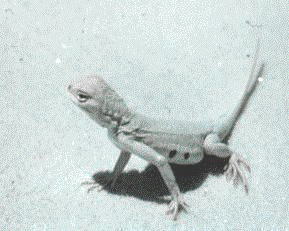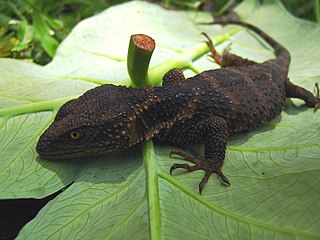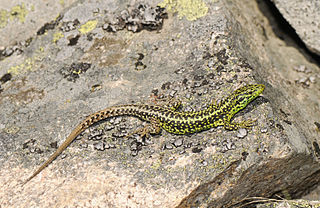
Lizards are a widespread group of squamate reptiles, with over 6,000 species, ranging across all continents except Antarctica, as well as most oceanic island chains. The group is paraphyletic as it excludes the snakes and Amphisbaenia; some lizards are more closely related to these two excluded groups than they are to other lizards. Lizards range in size from chameleons and geckos a few centimeters long to the 3 meter long Komodo dragon.

The emu is the second-largest living bird by height, after its ratite relative, the ostrich. It is endemic to Australia where it is the largest native bird and the only extant member of the genus Dromaius. The emu's range covers most of mainland Australia, but the Tasmanian, Kangaroo Island and King Island subspecies became extinct after the European settlement of Australia in 1788.

The earless monitor lizard is a semiaquatic, brown lizard native to the Southeast Asian island of Borneo. It is the only living species in the family Lanthanotidae and it is related to the true monitor lizards.

Tympanocryptis is a genus of Australian lizards in the family Agamidae commonly known as earless dragons.

Horned lizards (Phrynosoma), also known as horny toads or horntoads, are a genus of North American lizards and the type genus of the family Phrynosomatidae. The common names refer directly to their horns or to their flattened, rounded bodies, and blunt snouts.

Holbrookia is a genus of earless lizards, known commonly as the lesser earless lizards, in the family Phrynosomatidae. The genus contains six recognized species, which are found throughout the Southwestern and Central United States and northern Mexico. They are characterized by having no external ear openings, presumably to prevent soil from entering their bodies when they are digging.

The viviparous lizard, or common lizard,, is a Eurasian lizard. It lives farther north than any other species of non-marine reptile, and most populations are viviparous, rather than laying eggs as most other lizards do. The viviparous lizard is named for the fact that it is viviparous, meaning it not only lays eggs, but also gives birth to live young. It is the only species in the monotypic genus Zootoca. Both "Zootoca" and "vivipara" mean "live birth," in Greek and Latin respectively. It was called Lacerta vivipara until the genus Lacerta was split into nine genera in 2007 by Arnold, Arribas & Carranza.

Xenosaurus grandis, commonly known as the knob-scaled lizard, is a species of diurnal, terrestrial lizard endemic to Mexico and Guatemala. It primarily inhabits tropical rainforests. It dwells in rock crevices and eats insects.

The great spotted kiwi, great grey kiwi or roroa is a species of kiwi endemic to the South Island of New Zealand. The great spotted kiwi, as a member of the ratites, is flightless. It is the largest of the kiwi. The rugged topography and harsh climate of the high altitude alpine part of its habitat render it inhospitable to a number of introduced mammalian predators, which include dogs, ferrets, cats, and stoats. Because of this, populations of this species have been less seriously affected by the predations of these invasive species compared to other kiwi. Nonetheless, there has been a 43% decline in population in the past 45 years, due to these predators and habitat destruction. This has led it to be classified as vulnerable. There are less than 16,000 great spotted kiwis in total, almost all in the more mountainous parts of northwest Nelson, the northwest coast, and the Southern Alps. A minority live on island reserves.

The common side-blotched lizard is a species of side-blotched lizard in the family Phrynosomatidae. The species is native to dry regions of the western United States and northern Mexico. It is notable for having a unique form of polymorphism wherein each of the three different male morphs utilizes a different strategy in acquiring mates. The three morphs compete against each other following a pattern of rock paper scissors, where one morph has advantages over another but is outcompeted by the third.
Holbrookia approximans, the speckled earless lizard, is a species of earless lizard which is found in the Southwestern United States and northern Mexico. It is sometimes referred to as the western earless lizard.

Plestiodon is a genus of lizards in the family Scincidae (skinks). The genus contains many species formerly classified under the genus Eumeces, except those now placed in Mesoscincus. They are secretive, agile animals with a cylindrical body covered with smooth, shiny scales. They are distributed from East Asia to throughout North America from southern Canada south to Mexico, including oceanic islands such as Bermuda.

Iberolacerta is a genus of lizards in the family Lacertidae. The genus contains at least eight described species, which are mainly found in Spain and France. Iberolacerta horvathi has a wider geographic range, being distributed in Central Europe.

A xerocole, is a general term referring to any animal that is adapted to live in a desert. The main challenges xerocoles must overcome are lack of water and excessive heat. To conserve water they avoid evaporation and concentrate excretions. Some are so adept at conserving water or obtaining it from food that they do not need to drink at all. To escape the desert heat, xerocoles tend to be either nocturnal or crepuscular.

The regal horned lizard is a horned lizard species native to Mexico and the Southwest United States.
The gibber earless dragon, also known as the smooth-snouted earless dragon, is a species of agamid lizard endemic to Australia. It is one of a documented species of the genus Tympanocryptis, a group of small terrestrial lizards that feed off invertebrates and are characterised by the absence of an external ear structure.
Ctenophorus mckenziei, more commonly known as the Dwarf-bicycle dragon, is a species of endemic Australian lizard within the family Agamidae and genus Ctenophorus. Originally identified as the agamid Amphibolurus Mckenziei, the lizard had been identified within the regions of Western Australia and South Australia in which it occupied the shrubbery and woodland areas as its habitat. It was subsequently transferred to the genus Ctenophorus along with other Agamid species in which it shared similar morphology and characteristics. The name “Mckenziei” is in reference to Norman Leslie Mckenzie, who was a zoologist and discovered the existence of the lizard. Listed on the IUCN red list page, threats to its population numbers are detailed of least concern, however their numbers face threat due to habitat loss, climate change, and feral predators.

Holbrookia elegans, the elegant earless lizard, is a species of lizard native to the United States and Mexico.

Anolis gundlachi, also commonly known as the yellow-chinned anole, Gundlach's anole, or yellow-beard anole, is an oviparous, sexually dimorphic species of lizard in the family Dactyloidae. The species is endemic to Puerto Rico and lives in mountainous forests at high elevations. The diet of A. gundlachi consists mostly of insects. This species is also known for signaling other lizards through a modulated head bob display, with varying bobbing amplitudes and patterns based on an individual's distance from other lizards.




















